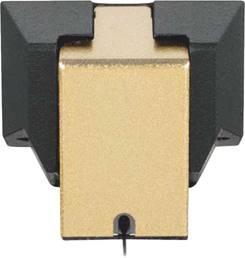MoFi UltraGold Review: Magnetic attraction
Already boasting a range of affordable turntables and a trio of MM pick-ups, a premium MoFi MC has finally arrived. Read our MoFi UltraGold Review.
There is much to be said for record labels also manufacturing playback equipment. As is the case with Decca, EMI, RCA and a few others in the past, Mobile Fidelity, aka MoFi, has continued to demonstrate this synergy through its portfolio of turntables, phono stages and three moving-magnet cartridges. The UltraGold is the first MoFi movingcoil offering, it raises the brand’s price point.
Working backward, with a £ gap between this and its dearest movingmagnet cart, there’s still a hole which could be filled with a less-expensive MC, but the UltraGold is such a classy offering at its price point that it probably won’t be needed: once you hear it, you’ll scratch around for the extra dosh. Yup, it’s that good. Equally, there is nothing to stop MoFi from producing a model above it. UltraPlatinum, anyone?
Secret weapon
There’s no mystery to this, because MoFi’s secret weapon, beyond manufacturing some of the finest sounding LPs ever pressed, is a wizard named Allen Perkins. His Spiral Groove turntables have always been ranked in the A-list and, among other innovations, have included a tonearm base inspired by interchangeable camera lens mounts.
With over 35 years experience in the hi-fi business, Perkins is perhaps best known for his fastidious approach and the UltraGold pick-up reflects this keen attention to detail.
ORIGIN USA
TYPE Medium-output moving-coil cartridge
WEIGHT 7.3g
FEATURES
• Nude Shibata stylus
• Boron cantilever
• Aluminum body
DISTRIBUTOR Karma-AV
WEBSITE mofielectronics. com karma-av.co.uk
He’s also a guitarist, so this MC is immediately identifiable as ‘musical’ rather than ‘analytical’. Then there’s his input into the UltraGold MC’s rather deceptive styling.
You might think it’s gonna be a proper pain in the keister to install, but the naked cantilever (which usually makes any buyer understandably nervous), and that host of angles begging to be lined up, render this one of the easiest cartridges we’ve ever installed. And that includes slab-bodied pick-ups that defeat the benefits of parallel sides with barely visible styli. Allen and the MoFi guys must have mused that this shouldn’t be compromised with operational quirks. During our testing period, we put it through its paces with three different phono stages and every time it works best with 100ohm loading. Moreover, the UltraGold sails through anything you subject it to at 2g.
The UltraGold’s recipe of nude Shibata stylus, boron cantilever, neodymium magnet and PC-OCC wiring could just as easily be used to describe a cartridge costing somewhere in the range. And no seasoned audiophile would blink.
MoFi has fitted this to an ultra-low resonance aluminium/brass extrusion. The body is threaded so there’s no fiddling with nuts and bolts and we manage to mount it in seconds – literally. Blessed, too, are the widely spaced, colour-coded pins, so there remains only one complaint to level at the UltraGold: safely removing it from the box without it coming to any grief.
For some reason, the ecologically minimalist packaging opens to reveal the UltraGold squeezed into a cut-out card aperture on a foam insert. There are no gaps around the cartridge to insert your fingers, so forcing it out with a blunt tool without dislodging the stylus guard is a tricky and nerve jangling business. MoFi, please take note in the future.
Sound quality
So how does it play? Well, any cartridge will perform at its very best when 99 percent of the vinyl played are normal pressings, so we take the important decision to at first listen

only to regular releases. First off the shelf is a 45rpm, 12in single of the Traveling Wilburys’ extended version of Handle With Care.
Although it’s a feast of guitar sounds, we chose it for another reason: all the voices – Jeff Lynne, Roy Orbison, Bob Dylan, Tom Petty and George Harrison – are almost embarrassingly familiar having been individually savoured by listeners all
This MC is very easily identifiable as ‘musical’ rather than ‘analytical’
over the world for a half-century or more. While distinguishing between them is nowhere near as tough as trying to hear the difference between, say, Zildjian and Paiste cymbals, and you’d have to be hearing-impaired not to identify Dylan versus Orbison, the UltraGold proves its worth by revealing the distinctive textures, breathing and phrasing with a facility one can only define as “vivid’.
We have no idea what microphones were used at the sessions or even if the vocals were laid down in separate studios. Whatever the case, the voices mesh with such mutual support, while maintaining each individual character, that we have a hard time resisting the temptation to spin more LPs by the Everly Brothers, Beach Boys, Hollies and other harmonious outfits just to confirm the repeatability of the experience.
The UltraGold – whatever else may be said about its strengths, and they are numerous – is midband-dominant in a good way. Like the widely celebrated BBC LS3/5A and Radford tube amps, it quite clearly adores and cossets the human voice. Is there a price to pay for this? The upper registers match the midband for authority and there’s plenty of good ol’ moving-coil warmth, but some listeners may find themselves searching for a touch more slam at the extreme bottom end.

The UltraGold boasts a nude Shibata stylus, boron cantilever and neodymium magnet

Playing War’s Greatest Hits 2.0, where the absolute weight of the sound is crucial, we are reminded that MoFi’s MMs have a touch more kick. The contrast is even more evocative of valves versus solid-state. To put this aspect of the sound to bed, and to not let it colour the impression, we must defer to the tube/transistor analogy, as divisive as it is. That’s kinda like saying that if you’re enamoured of MoFi’s MM models, you might be confused by its much dearer sibling.
Which is a nonsense: it’s more about presentation or character than absolute accuracy, and turning to War’s heavier tracks proves no less rewarding than listening to the vocals-centric Wilburys offering.
The lower registers are actually more extended than via the MMs, which may be an illusion if you’re comparing its drier, snappier sound to moving coil’s lushness, but, as usual, the ultimate deciding factor is your own personal preference.
Finally temptation gets the better of us and we return to The Beach Boys. The recent Feel Flows boxset provides one of the best-ever versions of Surf’s Up, and here’s where you can finally put to bed any perplexity over
MO’ MAGNETS
Launched in 2016, and also voiced by Spiral Groove founder Allen Perkins, the ‘Trackers’ are a trio of movingmagnet pick-ups bearing the MoFi moniker. Dubbed the StudioTracker, UltraTracker (HFC 434) and MasterTracker these bespoke MMs are built in Japan to MoFi’s specification – a key feature being their ‘V-Twin dual-magnet generator’ that matches the layout of the cutting head in MoFi’s lathes. The symmetry of that magnetic circuit is borne out in the matched L+R and L-R response and distortion traces of the MasterTracker, usurping the UltraGold MC in this regard. Otherwise, while the Tracker MMs and UltraGold MC are excellent, er, trackers the new MC has the edge here, as it
does with its more extended high treble response. This, in large part, is down to the superior profile of the UltraGold’s Shibata stylus, the enhanced rigidity of the boron cantilever and reduced moving mass of this ensemble and PC-OCC coils. The MasterTracker employs a similar Fine Line stylus, but – like all the Trackers – it has a crimped alloy cantilever and slightly stiffer suspension (lower compliance) than the MC. While it’s unusual for the MC in a family of pick-ups to have a higher compliance than its MM relatives, this does ensure the UltraGold will sail through the most violent of grooves without pause. It’s also better suited to the popular medium effective mass tonearms from the likes of SME, Rega and Pro-Ject too.
IN SIGHT

UltraGold’s versus MoFi MMs’ bottom octaves. That’s because of the way the former handles the liquidity of the sonic effects which permeate the album. There’s nothing punning about it, as the album is largely water-themed throughout. With Don’t Go Near The Water and Feel Flows, Brian Wilson uses this to remind us constantly that the LP has ‘surf in its title.
It’s rare that the outre adjectives which we’ve adopted over the decades to describe sound resemble a musical equivalent of a poet using onomatopoeia. I suppose ‘dry’ music should have been the basis for, say, the soundtrack to Lawrence Of Arabia, while you can come up with your own playlist for ‘chocolate’, ‘plummy’, ad infinitum.
Whatever adjectives the entire canon of hi-fi begs to use, one stands proud for the UltraGold and that is ‘fluid’. It’s not just the smooth conveying of liquidity in The Beach Boys album. It’s the consistency in the dynamic swings from soft to loud and back, the wholeness of the soundstage, the nature of the air around the instruments.
Back to Beatle George and moving on to his world-changing solo LP, All Things Must Pass, and its 50th

The host of angles and colour-coded pins make this an easy cart to install
Anniversary edition, we are faced with the tricky task of having to think of a sound quality that’s appropriate to the meaning of wah-wah, rich as it is with that specific guitar gizmo’s effect.
George was sparing with it, but the MoFi cartridge tracks the fluidity with such grace and consistency that we decide to slam on the handbrake, pull a U-turn and finally listen to a Mobile Fidelity LP.
And so, out comes arguably the most adventurous use of wah-wah pedal in the history of all guitar shenanigans – at least the equal of Jimi Hendrix’s exotic mastery of it – on Jeff Beck’s Truth, a 45rpm pressing on thick vinyl.
The UltraGold reveals distinctive textures one could describe as vivid
I Ain’t Superstitious does for wah-wah what actress Sue Lyon did for lollipops… The UltraGold MC follows every one of Beck’s sinewy moves so beautifully that we just have to sit back, marvel and play it three times in a row.
Conclusion
As we said at the very start, who better than a record label to develop a cartridge? After all, it’s surely in MoFi’s interest to make its vinyl sound as good as it possibly can.
The UltraGold is a hyper-modern take on classic MCs, retaining the virtues of warmth and air, but with trackability that has us looking for a ‘V15’ designation somewhere. Prices can seem formidable in high-end hi-fi, and when some top-end carts go on sale for in excess of £, the UltraGold, at one-tenth of that? Chalk up another MoFi bargain •
How it compare?
While MoFi’s new UltraGold is evidently a ‘well sorted’ MC, it needs every advantage it can get to compete in the busy space. There’s the old- but-still-very fine Cadenza Bronze MC from Ortofon – this is a heavier tracker at 2.5g, but the -0.4mV output is similar and there’s no mistaking the detail dragged out of those grooves by its Replicant 100 stylus. Or how about Rega’s evolved Apheta 3 MC (HFC 479)? The incisive sound of this classic continues to win it new fans, whether it’s fitted to a Rega deck or a competing ‘table.






